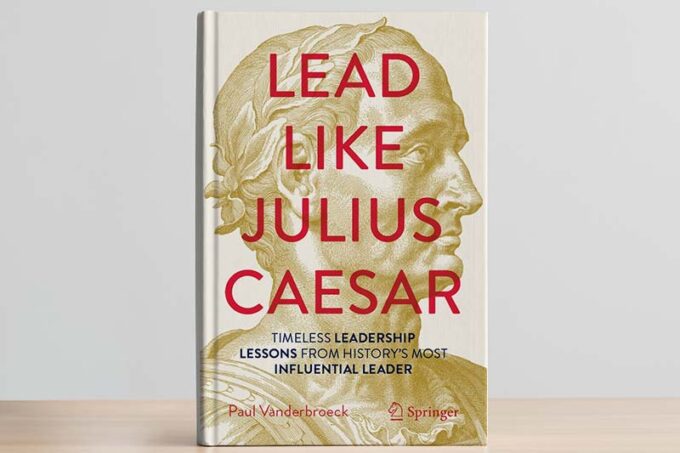I by IMD Book Club
Emotional intelligence
Leadership lessons from Julius Caesar: The brilliance and the blind spots
7 hours ago • by Paul Vanderbroeck, Susan Goldsworthy in I by IMD Book Club
IMD's Susan Goldsworthy was joined by Paul Vanderbroeck, whose unique book, Lead Like Julius Caesar: Timeless Leadership Lessons from History's Most Influential Leader, dissects the leadership style and career of the Roman...
IMD’s Susan Goldsworthy was joined by Paul Vanderbroeck, whose unique book Lead Like Julius Caesar: Timeless Leadership Lessons from History’s Most Influential Leader dissects the leadership style and career of the Roman emperor and offers a historical perspective to the challenges faced by today’s business leaders.
It’s not about seeing Julius Caesar as a role model, but as an example of a very successful but imperfect leader.Paul Vanderbroeck
What makes a leader truly influential across the millennia? For Paul Vanderbroeck, the answer lies not in perfection, but in understanding the interplay between remarkable achievement and human vulnerability. “It’s not about seeing Julius Caesar as a role model, but as an example of a very successful but imperfect leader.”

A jack of all trades, master of all
Caesar’s influence rests on breadth combined with excellence. “If you look back in history and rank the most successful leaders, Caesar will always end up in the top five – with his unique capabilities and experience as a statesman, a general, politician, change agent, or even as an author.”
This accumulation of achievement created an enduring legacy; Caesar remains the only leader whose name became synonymous with the highest authority – Kaiser in German, Tsar in Russian, and the modern American ‘czar,’ appointed to deliver special government projects.
Lessons from Caesar will help executives think about the conundrum: I’m good, but how can I get better? Help me learn and grow.
Bridging past and present
Vanderbroeck applies three leadership frameworks to Caesar’s story – theories he has used throughout his work as an HR executive and coach, and covers behaviors, personality, motivation, and leadership within a career structure.
- The Global Executive Leadership Mirror (GELM) is a 360-degree instrument that measures a leader’s capability across 12 critical leadership dimensions, such as visioning, empowering, and energizing, in a global context. This assessment focuses on a leader’s behaviors and competencies to deepen self-understanding and facilitate development.
- The Individual Directions Inventory (IDI) is a psychometric tool that explores an individual’s underlying motivations and emotional drivers. It identifies the areas from which a person gains the most emotional satisfaction, helping to explain their preferred actions and focus.
- The Leadership Pipeline Model is a framework that views leadership development as a continuum of progressive stages (or passages) within an organization. It emphasizes that as leaders advance, they must change their skills, time application, and work values to meet the demands of the new level, ensuring a steady flow of capable leaders throughout the organization.
This analytical approach revealed surprising insights. The IDI framework suggested Caesar as a leader driven by excellence and recognition who wanted not just good results, but acknowledgment for them. “He never stopped. He went on and on and on, and that’s also part of his success, but also, in a certain way, part of his failure.”
More surprisingly, this drive appeared rooted not in personal ambition alone, but in fulfilling expectations of his family and the Roman Republic. His mother, Aurelia, steered Caesar toward restoring the family’s status. Yet Caesar’s relentless focus on achievement caused him to forget “that perhaps it’s not only about his own achievement, but about the achievement of the organization which we need to bring along,” Vanderbroeck notes – a blind spot familiar to many modern executives.
The power of narrative
Caesar mastered a skill many contemporary leaders struggle with: storytelling. His commentaries on the Gallic Wars represent a type of embedded journalism with Caesar writing about himself in the third person, creating an honest narrative that built his brand through sharing and valuing others’ contributions and discussing vulnerabilities alongside successes.
The fatal flaw
Caesar’s biggest weakness was his inability to sense what was happening beneath the surface in larger groups. This blind spot appeared repeatedly – in Gaul, during the civil war, and finally in the Senate. “He thought he had pacified the situation, and then, boom – there was a big revolt. Each time he barely escaped, until that last time, when he was not able to.”
The failure wasn’t just individual – it was systemic.
Caesar was “low on receiving,” Vanderbroeck notes, meaning he didn’t make it easy for people to give him feedback. When you have a very self-assured leader in a position of power, people below often assume the boss doesn’t need their input. The solution? “As a leader, then and now, you really need to go out there and proactively draw all that information which otherwise you’re missing.”
Thatcher and Caesar: The parallels of power
When discussing betrayal, Vanderbroeck draws a striking parallel to the fate of Margaret Thatcher, UK Prime Minister from 1979 to 1990. “What happened to Caesar at the end is also a Thatcher scenario,” he observes. “In Caesar’s day, people were literally stabbed in the back; nowadays we stab people in the back metaphorically – that’s what we call civilization.” Both leaders fell victim to the same dynamic: they didn’t invite feedback, and those around them assumed they didn’t need it.
The human question
Given the opportunity to ask Caesar one question, Vanderbroeck wouldn’t inquire about military strategy. Instead, he’d ask: “What makes you laugh?”
“That’s an aspect of Caesar which we haven’t any information about,” he explains. “Where was the lightness in his life, and the joy and the playfulness?”
It’s a question Vanderbroeck asks modern executives as well. “In my coaching, I increasingly come across the issue of stress levels, and I’ve seen it increase over the years. As part of building resilience, you should discuss where the joy in the executive’s life is as a whole. This is a helpful conversation.”
Caesar as a mirror
The book’s deeper purpose crystallizes around Goldsworthy’s insight: “It’s not just about him. It’s about us. It’s about what it is to be human.”
While ostensibly about Julius Caesar, the work explores what it means to lead and remain human amid relentless demands for performance. For contemporary business leaders, the value lies in recognizing patterns that persist: the drive for recognition, the challenge of receiving honest feedback, and the tension between personal ambition and organizational goals.
The critical lesson centers on feedback and emotional intelligence. “Feedback is important for any type of competency development, particularly in areas of weakness,” Vanderbroeck emphasizes. “It helps ensure that they don’t become barriers to your success.”
For those starting careers, Caesar’s example emphasizes operational experience and early risk-taking, where mistakes are rarely career-ending. For senior executives, the lesson is sobering: proactively seek the honest feedback that naturally becomes harder to obtain as you rise.
Asked where we would find Caesar today, Vanderbroeck envisions him in a high-tech firm. “He was really motivated by change, and by innovation and technology. Running a bureaucracy would have frustrated and bored him.”
Caesar’s story becomes a mirror – reflecting not what leaders should be, but what they might discover about themselves. His struggles with feedback, blind spots around group dynamics, and relentless work ethic driven by external validation aren’t merely historical curiosities. They echo through boardrooms today.
As Vanderbroeck concludes: “It’s that growth mindset. Lessons from Caesar will help executives think about the conundrum: I’m good, but how can I get better? Help me learn and grow.”
Authors

Paul Vanderbroeck
Executive Educator and Coach
Paul Vanderbroeck is a Swiss-Dutch historian, leadership scholar, and executive coach. He has accompanied many leaders and high-potential individuals across the world in their leadership careers. Among his publications are Leadership Strategies for Women (Springer, 2014) and The International Career Couple Handbook (2021). He has co-created a play on women leaders. He is married with two adult children and currently lives in Geneva, Switzerland.

Susan Goldsworthy
Affiliate Professor of Leadership, Communications and Organizational Change at IMD
Susan Goldsworthy OLY is an Affiliate Professor of Leadership, Communications and Organizational Change at IMD. Co-author of three award-winning books, she is also an Olympic swimmer. She is a highly qualified executive coach and is trained in numerous psychometric assessments. She is Director of the IMD Executive Coaching Certificate and Program Director of the Leading Sustainable Change program.
